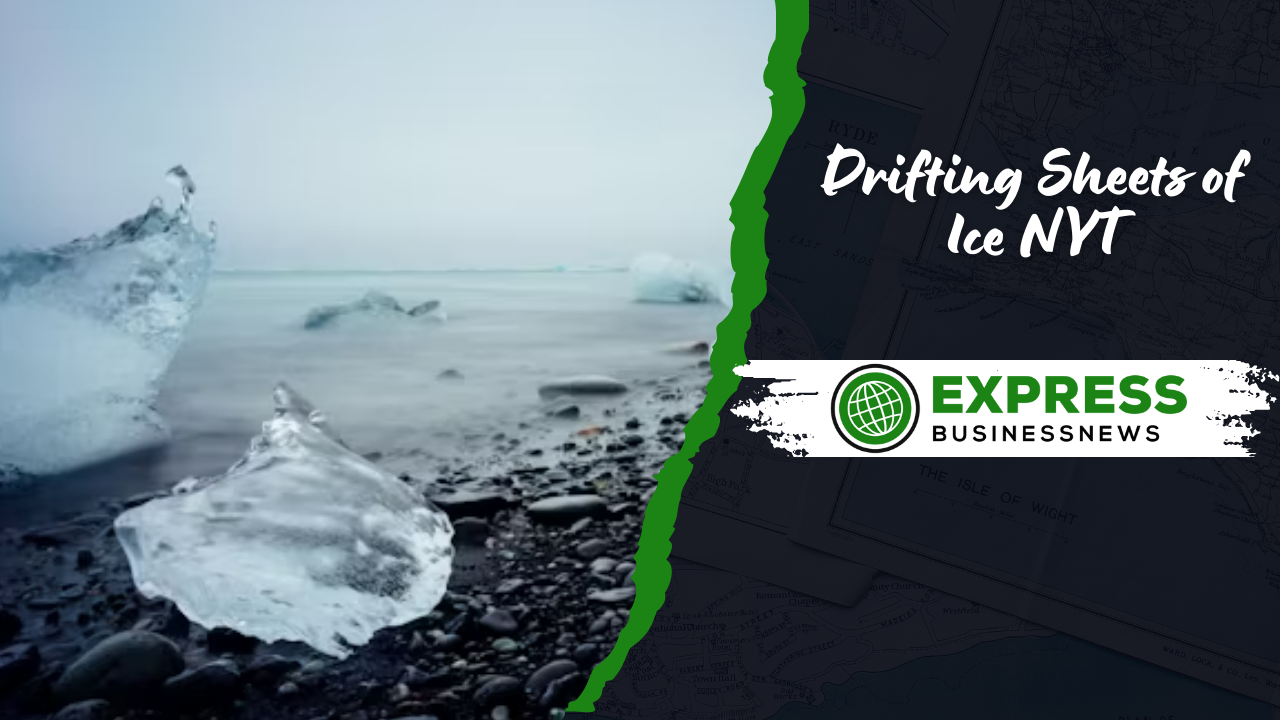Introduction to Drifting Sheets of Ice NYT
The Arctic region, with its vast expanses of ice and extreme conditions, has long been a subject of fascination and study. Among the many phenomena that characterize this icy wilderness, the Drifting Sheets of Ice NYT stand out as a powerful symbol of the region’s dynamic and changing nature. These massive, floating ice formations, often called sea ice, are a crucial feature of the Arctic Ocean. They shape the landscape and play a critical role in the global climate system.
The Drifting Sheets of Ice NYT of the Arctic are not just a natural wonder but a significant indicator of the planet’s health. As climate change continues to impact the Earth, the behavior and characteristics of these ice Drifting Sheets of Ice NYT are undergoing profound changes. This article delves into the phenomenon of Drifting Sheets of Ice NYT, exploring their formation, movement, and the implications of their changes for the global climate. We also examine the human activities and environmental factors contributing to the rapid transformations in the Arctic and what this means for the future of the region and the planet.
Formation of Arctic Drifting Sheets of Ice NYT
The Process of Sea Ice Formation
Sea ice in the Arctic forms when ocean water cools to the freezing point and solidifies. This process begins with the formation of tiny ice crystals, known as frazil ice, which float on the water’s surface. As these crystals accumulate, they merge into more giant formations called grease ice. Over time, grease ice thickens and solidifies, forming a thin, continuous layer of ice known as nilas.
The thickness and extent of sea ice vary depending on several factors, including air temperature, ocean currents, and the salinity of the water. When it drops significantly in winter, the ice thickens and spreads, covering a larger area. Conversely, during the summer, rising temperatures lead to the melting and retreat of sea ice. This seasonal cycle of growth and decline is a natural part of the Arctic environment, but the effects of global warming have increasingly disrupted it.

The Role of Sea Ice in the Arctic Ecosystem
Sea ice is a crucial component of the Arctic ecosystem. It is a habitat for various species, from microorganisms to large mammals like polar bears. The ice provides a platform for these animals to hunt, breed, and rest. For example, polar bears rely on sea ice to hunt seals, their primary food source. Without adequate ice cover, these apex predators struggle to find food and are forced to expend more energy swimming long distances.
Sea ice also plays a vital role in regulating the Earth’s climate. It has a high albedo, reflecting a significant portion of the sun’s radiation into space. This reflective quality helps to keep the polar regions cool and moderates the global climate. However, as sea ice melts, it exposes the darker ocean water underneath, which absorbs more solar energy and accelerates warming—a phenomenon known as the albedo effect.
Movement and Dynamics of Drifting Sheets of Ice NYT
Factors Influencing Ice Movement
Sea ice movement is influenced by a combination of wind, ocean currents, and the Earth’s rotation. These forces cause the ice to drift across the Arctic Ocean, sometimes covering hundreds of miles. The Coriolis effect, resulting from the Earth’s rotation, causes the ice to move clockwise in the Northern Hemisphere. Wind patterns, particularly the polar vortex, play a significant role in driving the drift of ice Drifting Sheets of Ice NYT. When the vortex is strong, it can increase ice formation and compact the ice into denser formations. Conversely, when the vortex weakens, it can cause the ice to disperse and break apart, leading to more open water areas.
The Phenomenon of Ice Breakup and Rafting
One of the most dramatic aspects of sea ice dynamics is the breakup and rafting of ice Drifting Sheets of Ice NYT. Large Drifting Sheets of Ice NYT can fracture into smaller pieces as temperatures rise and the ice thins. The action of wind and waves often accelerates this breakup. The ice is broken into smaller floes; these pieces can move independently, sometimes colliding and piling up on top of each other in a process known as rafting.
Rafting can create thick, uneven ice formations, challenging navigation in these regions. It also influences the overall thickness and stability of the ice cover. As the ice continues to drift and interact with the surrounding environment, it undergoes further thickness, extent, and composition changes. This dynamic process is a key focus of scientific research, as understanding it is crucial for predicting future changes in the Arctic.
Climate Change and Its Impact on Arctic Sea Ice
Rising Temperatures and Melting Ice
The Arctic is warming more than twice the global average, a phenomenon known as Arctic amplification. This rapid warming has profound effects on the region’s sea ice. Over the past few decades, satellite observations have shown a significant decline in the extent and thickness of Arctic sea ice. The summer minimum ice extent, typically in September, has decreased by about 13% per decade. The loss of sea ice is a sign of warming and a contributor to further climate change. As more ice melts, the darker ocean water absorbs more heat, leading to additional warming and ice loss. This positive feedback loop accelerates the decline of sea ice and contributes to global climate changes.
The Consequences of Diminishing Sea Ice
The reduction in Arctic sea ice has far-reaching consequences, both locally and globally. In the Arctic, ice loss affects the region’s wildlife, indigenous communities, and the overall ecosystem. Species that depend on sea ice for survival, such as polar bears, seals, and walruses, face challenges as their habitats shrink. Indigenous peoples, who rely on the ice for hunting and transportation, are also impacted by these changes.
Globally, the loss of sea sea can disrupt weather patterns and ocean currents. The Arctic is a refrigerator for the planet, and its cooling effect helps moderate global temperatures. As the ice diminishes, this moderating influence weakens, potentially leading to more extreme weather events, such as heatwaves and storms, in other parts of the world. Additionally, melting sea ice contributes to rising sea levels, which threaten coastal communities worldwide.
Human Activities and Environmental Concerns

The Role of Industrial Activities
Human activities, notably the burning of fossil fuels, are the primary drivers of the warming that leads to sea ice loss. The release of greenhouse gases, such as carbon dioxide and methane, traps heat in the Earth’s atmosphere, causing global temperatures to rise. The Arctic is particularly sensitive to these changes, and the loss of sea ice directly results from increased atmospheric warming.
Beyond contributing to climate change, industrial activities in the Arctic, such as oil and gas exploration, shipping, and mining, pose additional threats to the region’s environment. The reduction in sea ice has made the Arctic more accessible to these activities, leading to concerns about the potential for oil spills, habitat destruction, and the disturbance of marine life.
The Debate Over Arctic Development
The opening of the Arctic due to sea ice loss has sparked a debate over the region’s future. On one hand, the reduction in ice cover presents new economic opportunities, such as shorter shipping routes through the Arctic Ocean and access to untapped natural resources. On the other hand, these activities pose significant environmental risks and could exacerbate the impacts of climate change.
Many environmentalists and scientists advocate for the protection of the Arctic, arguing that the region should be preserved as a critical component of the Earth’s climate system. They emphasize the importance of reducing greenhouse gas emissions and implementing policies that limit industrial activities in the Arctic. The debate over Arctic development is complex and involves balancing economic interests with environmental and ethical considerations.
The Future of Arctic Sea Ice
Predicting the Fate of Sea Ice
Predicting the future of Arctic sea ice is challenging, as it involves understanding a complex interplay of factors, including atmospheric conditions, ocean currents, and human activities. Climate models suggest that the Arctic could be virtually ice-free in the summer months within the next few decades if current warming trends continue. The timing and extent of this ice loss will depend on the global greenhouse gas emissions rate and the effectiveness of efforts to mitigate climate change. Continued scientific research is essential for improving our understanding of the processes affecting sea ice and for developing more accurate models to predict future changes. This research can inform policy decisions and help guide efforts to protect the Arctic environment.

The Importance of Global Action
The changes occurring in the Arctic are a stark reminder of the global nature of climate change and the need for international cooperation to address its impacts. The loss of sea ice is not just an Arctic issue; it has implications for the entire planet. Reducing greenhouse gas emissions is crucial for slowing the rate of warming and mitigating the impacts on sea ice and the broader climate system. Efforts to protect the
Arctic also require a commitment to sustainable practices and protecting Giovanni’sue ecosystems. This includes implementing regulations to limit industrial activities, promoting conservation efforts, and supporting the resilience of indigenous communities. The future of the Arctic and the Drifting Sheets of Ice NYT that define it depend on the actions taken by the global community to address climate change and protect this critical region.
Conclusion: The Melting Edge of the Arctic
The Drifting Sheets of Ice NYT in the Arctic are more than just a natural wonder; they are a critical component of the Earth’s climate system and a symbol of the changes occurring in our world. The rapid loss of sea ice due to climate change clearly indicates the challenges we face in managing and protecting our planet’s environment.
As we look to the future, it is essential to recognize the importance of the Arctic and the need for concerted efforts to mitigate the impacts of climate change. The fate of the Drifting Sheets of Ice NYT ice Drifting Sheets of Ice NYT and the Arctic as a whole will depend on our collective actions and commitment to sustainability. By addressing the root causes of climate change and protecting the unique ecosystems of the Arctic, we can work towards a more stable and resilient future for all.





